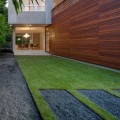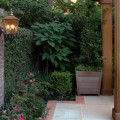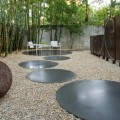Minimal Landscape

The minimal landscape is an unyielding style of professional landscaping that offers us no validation of our assumptions or preconceptions.
Many of the forms we expect to find on the Houston landscape are strangely absent. What forms are present are fewer in number, and they are not always in the places we would normally expect to find them. This is because their job is to establish challenging patterns that represent the highly abstract associative faculties of the human mind.
It is necessary, therefore, for the landscape designer to both avoid predictability, and to avoid creating too many landscape elements that would be contrary to the existential nature of minimalism. To be effective, the landscape must challenge us to create meaning for ourselves using only the raw mathematical materials of geometry and corollary to construct an entirely new view of the world that replaces the one we were handed as unconscious children.
Through its less-is-more profusion of raw, basic forms, minimal landscape challenges the viewer to define life through cognitive experience alone.
Unlike traditional landscapes where garden design generate emotional states that create a highly desirable quality of outdoor living, minimal landscapes permit no such luxuries and allow no such comfort zone to exist independently of the ones we create within ourselves.
Elements are often asymmetrical and arranged in patterns that do not immediately appear to the socially conditioned mind.
Many people are immediately disturbed by minimalism negation of objective, universal truth. They feel it deconstructs the world too much, and then leaves it disassembled on the ground.
This is exactly what minimal landscapes are supposed to do—strip away what the viewer perceives reality to be, and to assert that true reality is only what we create through cognitive association and conscious relationships.
This is why inorganic landscape elements are favored above the organic. They take us to a more mental plane by minimizing the excitement level of the senses and by creating the sense that organic energy is tightly controlled and limited.
Hardscapes are used to map out geometry, and gravel is frequently used as a substitute for grass. Even minimalist gardens, which have to contain some plants to qualify as gardens, nonetheless have an equivalent amount of décor such as glass steel posts, wires, and mirrors.
On a minimal landscape, colors are limited and basic.
Many patios, walkways, motorcourts, and retaining walls are built out of concrete without any effort to alter its natural color. Gravel is usually white or gray, and stone is typically dark gray or black with a polished shine. Plant life tends to be dark green with white flowers so as to better blend with the manmade elements around it. This also keeps the scene from looking too lively.
Water features are very important to minimal landscapes.
They suggest a curious fusion between the inorganic and the organic. Water is, in many respects, a mystery of sorts. As non-living substance, it is ironically the one thing that all living things need. In minimalist design, water is a powerful aesthetic fuel for cognitive processing.
Any fountain, infinity pond, or reflecting pool creates an immediate focal point where many different areas of interest converge and give life to the seeds of new thought.





